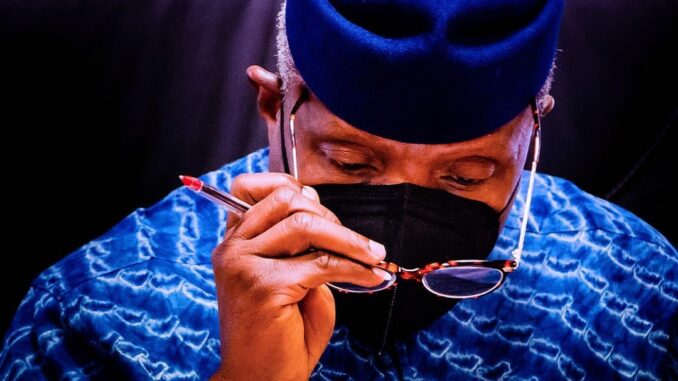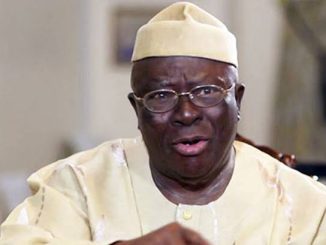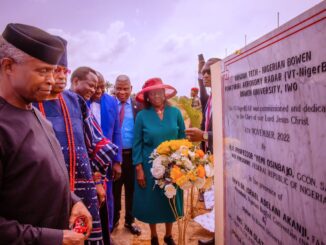
In this piece, OLAOYE AYOTUNDE reflects on the national economic plans of the President Muhammadu Buhari administration, rooted and implemented under the National Economic Sustainability Plan (NESP) as piloted by Vice President Yemi Osinbajo, who has been credited for the success of the initiative over his masterful administrative style .
It was Henry Douglas Dickinson, 1899-1968, a top Cambridge-trained historian of economic thought, who said: “Economic planning is the making of major economic decisions — by the conscious decision of a determinate authority, on the basis of a comprehensive survey of a country’s existing and potential resources and a careful study of the needs of the people.”

Photos: State House/Tolani Alli
By implication, what he is saying is, “On the basis of the available resources and the needs of the people, development plans for a definite period are prepared beforehand by the central planning authority. And then the economic activities of the country are directed towards the implementation of the plans.”
Thus, essentials of a good plan must include, “an economic plan based upon the initial resources of the country, presupposing a careful inventory of present and future availability of manpower and domestic resources,” as much as setting up “feasible targets or goals for the terminal date.”
The economist said, such economic planning “sets out the feasible policies that permit achievement of the terminal (end-period) goals from the initial resources taking into account the intermediate economic resources that can be imported from abroad (through loans or gifts) and that can be produced at home out of the initial resources by the mechanism of domestic investment.”
It must also have “basic features” and whose basic objective of planning is “to exercise control over the private sector of an economy,” while he said “controls are exercised over scarce economic resources. When the economic resources of the country are rationally arranged with a predetermined purpose, it is called economic planning. It usually refers to planning by the State.
The economist listed important essential features of economic planning thus: “There must be a centralised planning authority for preparing the plans and suggesting the means for their implementation; and “before framing the plan, the planning authority should undertake an accurate survey of the available resources (both existing and potential) and the essential needs of the country.”
He also said: “An economic plan must have some definite aims and objectives;” not only that, “the plan should lay down a series of targets on the different lines of production such as agricultural, industrial,” and so on; while stating that a good economic planning, “should make a proper allocation of the proposed outlay into the different heads of development.
Similarly, “an economic plan must have a definite time limit, usually 5 years (as in our country) and there must be mutual consistency between the targets of the production of the different sectors,” the economist said.
Like corroborating H. D. Dickinson, other experts have succinctly put economic planning as “a resource allocation mechanism based on a computational procedure for solving a constrained maximization problem with an iterative process for obtaining its solution,” or as a process by which “key economic decisions are made or influenced by central governments.”
ALSO READ: ESP aimed at mitigating macroeconomic shocks — Osinbajo
This is why different countries of the world do prepare economic planning to cushion the effects of economic depression or in order to plan for the economic future of a State.
Same way, Nigeria under the Buhari-Osinbajo administration has since keyed into the need to properly plan for her economy, just as H. D. Dickson put it, knowing a proper plan is the fulcrum for national development.
Representing the Federal Government, Vice President Yemi Osinbajo, SAN, who by his statutory constitutional role as the Chairman of the National Economic Council (NEC), has piloted different policies as approved by President Muhammadu Buhari for execution, one of which was the Economic Sustainability Plan (ESP), put in place, primarily to take care of the fallout of COVID-19 devastation among Nigerians in their private and business lives.
When the Covid-19 pandemic initially broke out in Nigeria in early 2020 followed by economic depression all over the world, Nigeria inclusive, to arrest the situation, President Mohammed Buhari set up an economic sustainability committee headed by the Vice President to look into how the pandemic will not have adverse effects on the economy of Nigerians and that of the country.
Immediately after their inauguration, Vice President Osinbajo and his team quickly swung into action and at the end of the day came out with an unprecedented Economic Sustainability Plan (ESP) initiative for the country.
It was through the ESP module Vice President Osinbajo and his committee developed an economic sustainability plan that touched every sector of the national economy, with so many other components catering to the personal needs of millions of Nigerians till date.
One of such branches of empowerment in the Economic Sustainability Plan is the Micro, Small, and Medium Enterprises (MSMEs) component, which also has in it the payroll support for people working in the private sector, especially in private schools, where employees were paid N30,000 monthly for three months. This support initiative undoubtedly lifted the burden of salaries off the shoulders of employers who could not generate any income as of the time the COVID-19 pandemic was hard on the polity.
Besides the private sector beneficiaries, the N30,000 support scheme was also paid as a one-off grant to artisans who could not go out to make a living because of the nationwide lockdown. Likewise, sum of N50,000 MSME support grant was equally paid to the Chief Executive Officers (CEOs) of small enterprises to inject into their businesses which were affected by the COVID-19 pandemic.
Further to these support initiatives, the Central Bank of Nigeria (CBN) also rolled out COVID-19 loans of different categories to revive businesses that were negatively affected by the pandemic, all under the ESP initiative. It was this MSMEs survival fund which cushioned the effects of the national economic downturn it was said brought Nigeria out of recession two times after the COVID-19 pandemic devastation.
Another important aspect of the ESP component Vice President Osinbajo and his team put in place to benefit Nigerians was the Mass Housing Programme (MHP). In the approach to this, the MHP was introduced to deliver up to 300,000 homes every year. The modalities set for this is for young professionals and artisans to organise themselves into small and medium scale co-operative businesses within the construction industry to develop these houses, which will be based on a set of standardized designs, while the material for building, especially cement, will be offered at reduced prices which is still to be funded by the government.
This programme will also prioritize the use of local labour and materials. Doors, windows and other materials will be produced, finished or assembled at mass housing construction sites. The local contents will be patronised 100% and automatically, this will boost the economy of stakeholders in these industries.
There is also the Mass Agriculture component of the Economic Sustainability Plan serving the agricultural sector with a plan to ensure the cultivation of between 20,000 and 100,000 hectares of new farmland in every state, as well as support offtake and agro-processing, with low-interest credit.
• The idea, as defined by the government is to create millions of direct and indirect job opportunities, while the infrastructural part of the programme is also set to benefit the generality of Nigerians. As made known, it is already segmented into about four components which include; the Extensive Public Works and Road Construction Programme; having in it the engagement of a minimum of 1,000 young Nigerians recruited per Local Government into what was announced as the largest public works programme in the history of Nigeria, amounting to 774,000 direct jobs, with individuals to be paid N60,000 from the sum of N52 billion appropriated for the scheme.
There will also be an extensive focus on the construction and repair of major and rural roads using locally available materials like limestone, cement and granite. The roads component will include the acceleration and expansion of the scope of the Road Infrastructure Tax Credit Scheme (RITCS).
• Further to the Mass Housing Programme (MPH) earlier mentioned, in such houses will be the implementation of another programme called the installation of Solar Home Systems (SHS). But overall, other categories of Nigerians will benefit from the scheme targeting 5 million households, serving about 25 million individual Nigerians who are currently not connected to the National Grid. Solar equipment manufacturers will be required to set up production facilities in Nigeria, to provide the materials required.
• Added the ESP bumper package is the Investment in Healthcare Infrastructure which will be done through a special intervention fund, as well as by tapping into an existing World Bank facility termed the Regional Disease Surveillance Systems Enhancement (REDISSE) programme as a buffer for the COVID-19 interventions in the states.
The REDISSE project is aimed at strengthening the national and regional cross-sector capacities for disease surveillance and also providing an immediate and effective response in the case of eligible health emergencies. Coupled with this, the government also planned to expand the National Social Investment Programme through the ESP.
• The Federal Government has said that the expansion plans for the National Social Investment Programmes (NESP) implementation will see to an increase in the number of cash transfer beneficiaries, N-Power volunteers and sundry traders enjoying small and microloans through the MarketMoni and TraderMoni schemes. The pre-existing conditional cash transfer will also be extended to cover a larger number of extremely poor and vulnerable Nigerians.
What makes this economic planning different in setting achievable goals and patterned along with the Henry Douglas Dickinson definition earlier given to it is the practicable and patriotic input of the Vice President Osinbajo-led committee. Much more, the Buhari-Osinbajo administration has since presented itself as a people-friendly one. Now, it is worth mentioning that the Osinbajo Style, as someone who has a mind for the betterment of Nigerians and especially the liberation of the poor masses, made it work. It wasn’t this good looking through the past activities of his predecessors, even in fulfilling their statutory constitutional role as chairmen of the National Economic Council (NEC).
One can then come to a conclusion that Vice President Osinbajo being a good person has played a major role in the planning and implementation of the economic sustainability plan that was submitted to the President just because he has a soft touch for President, as attested to President Buhari himself, who at a time described his Vice President as “a reliable and dedicated deputy.”
“I’m proud to have selected Osinbajo as my running mate and he has given a good account of himself since our journey began in 2015. The Vice President is a cool-headed gentleman who puts the interest of Nigeria above other narrow considerations. Vice President Osinbajo is an incredibly patient politician who demonstrates remarkable intellectual and mental energy in the discharge of his duties,” President Buhari was quoted to have said, celebrating Vice President Osinbajo on his 64th birthday celebration.
The presidential endorsement is enough as a testament to Vice President Osinbajo’s forthrightness, exemplifying why he has been a success thus far!




